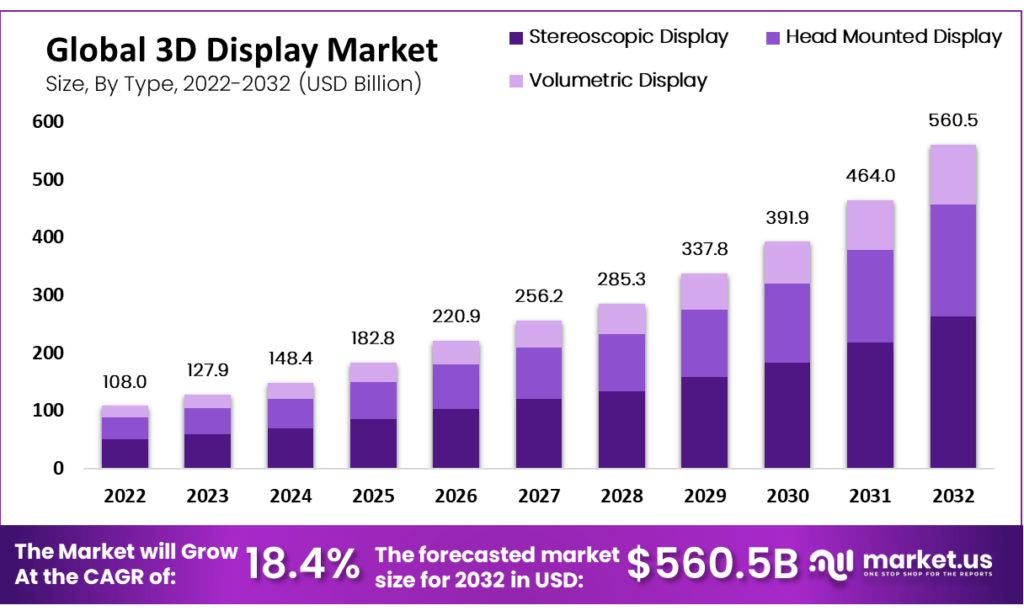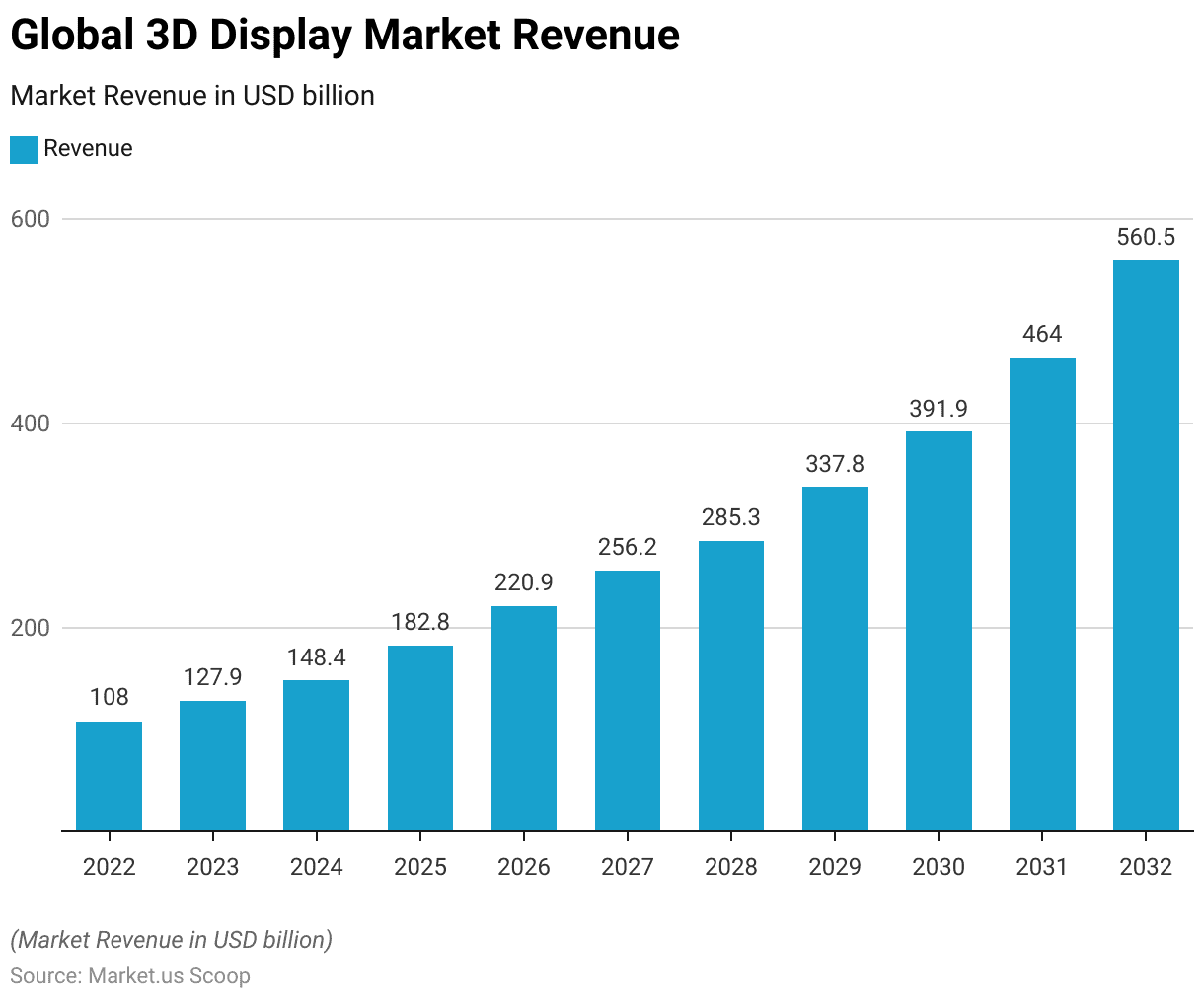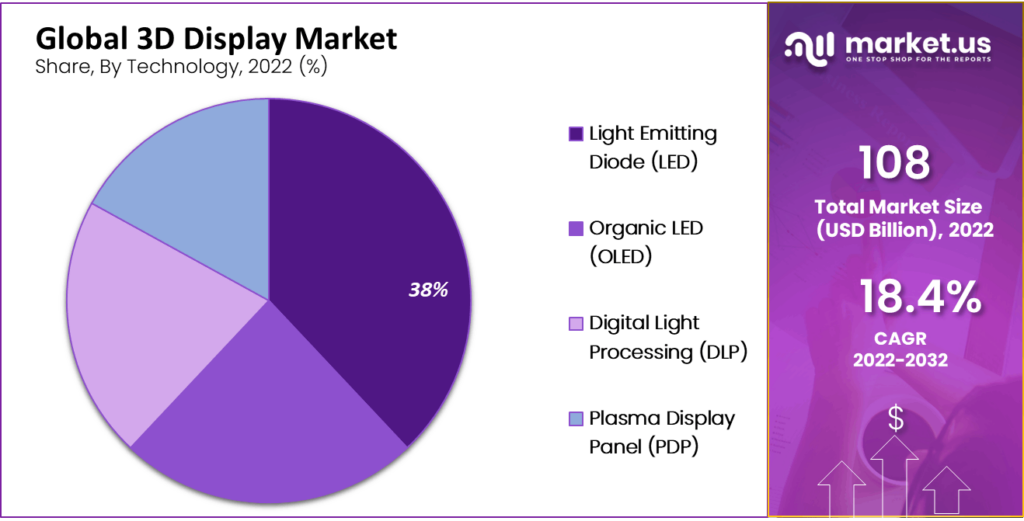Table of Contents
Introduction
According to 3D Display Statistics, 3D displays, employing techniques such as stereoscopy, holography, and volumetric rendering, provide immersive visual experiences by replicating depth and spatial dimensionality.
Stereoscopic displays create depth perception by presenting distinct images to each eye, while holographic displays project three-dimensional images without glasses using coherent light sources.
Volumetric displays generate images within physical space, allowing viewing from different angles. Widely utilized across entertainment, healthcare, automotive, aerospace, and retail sectors, 3D displays enhance gaming, medical imaging, driver assistance, flight simulation, and product visualization.
Despite challenges such as complexity and cost, advancements in resolution and content creation are bolstering adoption and user experiences.
Ongoing research targets depth perception improvement and reduced reliance on specialized equipment, ensuring ongoing innovation in 3D display technology.
Editor’s Choice
- The global 3D display market revenue is forecasted to reach USD 560.5 billion by 2032.
- Stereoscopic displays consistently dominated the market, with revenues climbing from 69.45 billion USD in 2024 to 262.31 billion USD in 2032.
- Light-emitting diode (LED) technology commands the largest market share at 38% and is known for its energy efficiency, vibrant colors, and longevity.
- Film-based stereoscopic transparencies have been in existence since at least 1931 when Tru-Vue introduced sets of stereo views on 35 mm film strips for viewing through a handheld Bakelite viewer.
- Customers frequently report numerous benefits after utilizing 3D holograms. These include a significant increase in lead generation by up to 30%, smoother initiation of discussions for the sales team, prolonged dwell times at trade fair stands, and enhanced sales performance both at the point of sale and in food retail environments.
- Virtual reality headsets like the Oculus Rift and PlayStation VR employ 3D computer display technology by displaying separate images for each eye.
- Innovations in light field glasses-free 3D bring immersive experiences to consumer devices, while holographic waveguide displays provide AR devices with a wide field of view and minimal eye strain.

Global 3D Display Market Overview
Global 3D Display Market Size
- The global 3D display market revenue, measured in USD billion, has demonstrated a consistent upward trajectory over the years at a CAGR of 18.40%.
- Beginning at 108.0 billion in 2022, the revenue saw substantial growth, reaching 127.9 billion in 2023 and further escalating to 148.4 billion in 2024.
- This positive trend is expected to continue, with projections indicating revenue figures of 182.8 billion in 2025, 220.9 billion in 2026, and 256.2 billion in 2027.
- Looking ahead, the market is forecasted to experience robust expansion, with revenue anticipated to soar to 464.0 billion in 2031 and reach a substantial 560.5 billion by 2032.

3D Display Market Size – By Type
- In 2022, the total market revenue stood at 108.0 billion USD, with stereoscopic displays contributing 50.54 billion USD, head-mounted displays 37.37 billion USD, and volumetric displays 20.09 billion USD.
- This trend continued to escalate, with revenues reaching 560.5 billion USD by 2032.
- Stereoscopic displays consistently dominated the market, with revenues climbing from 69.45 billion USD in 2024 to 262.31 billion USD in 2032.
- Head-mounted displays and volumetric displays also experienced significant growth, with revenues rising from 51.35 billion USD and 27.60 billion USD in 2024 to 193.93 billion USD and 104.25 billion USD, respectively, by 2032.

Global 3D Display Market Share – By Technology
- In the realm of display technology, various methods compete for market dominance, each offering distinct advantages and applications.
- According to the latest data, light-emitting diode (LED) technology commands the largest market share at 38% and is known for its energy efficiency, vibrant colors, and longevity.
- Following closely behind is Organic LED (OLED) technology, holding a significant 24% share, prized for its thinness, flexibility, and superior contrast ratios.
- Digital Light Processing (DLP) technology captures 21% of the market and is renowned for its high-resolution projection capabilities and fast response times.
- Lastly, plasma display panel (PDP) technology maintains a notable 17% share, which is recognized for its deep blacks, wide viewing angles, and suitability for large displays.

History of 3D Display Technology
- The evolution of 3D display technology spans centuries, with key milestones shaping its development.
- Beginning with Charles Wheatstone’s stereoscope in 1838, which presented two images to each eye for depth perception, the concept progressed with Louis Ducos du Hauron’s introduction of anaglyph images in the late 19th century.
- Commercial success arrived in 1939 with the View-Master, followed by polarized 3D Technology in the 1950s.
- The late 20th century saw the rise of virtual reality (VR) and autostereoscopic displays, offering immersive experiences without glasses.
- Holographic displays emerged as a promising technology, projecting lifelike 3D images without the need for glasses. Recent advancements in LCD and OLED technology have further enhanced 3D display quality and resolution.
Types of 3D Displays
Stereoscopic Displays
- Stereoscopic displays, often known as “stereo displays,” “stereo 3D displays,” or “stereoscopic 3D displays,” and occasionally mistakenly labeled as simply “3D displays,” employ a fundamental method of presenting offset images separately to the left and right eye.
- This technique, rooted in the principles of stereopsis articulated by Sir Charles Wheatstone in the 1830s, offers viewers distinct images for each eye, enhancing depth perception and creating a three-dimensional visual experience.
- Film-based stereoscopic transparencies have been in existence since at least 1931 when Tru-Vue introduced sets of stereo views on 35 mm film strips for viewing through a handheld Bakelite viewer.
- This Technology was further miniaturized and modified in 1939 with the introduction of the View-Master, which utilized cardboard disks containing seven pairs of small Kodachrome color film transparencies.
Holographic 3D Display
- A 3D hologram is a projection situated in space, visible to all without the need for specialized glasses. Unlike movies on standard monitors, a 3D hologram can be viewed from all angles, allowing viewers to move around it for a lifelike experience.
- This accessibility, without the requirement for 3D glasses like those needed for 3D TV or Virtual Reality, makes 3D holograms particularly advantageous for exhibitions and other events.
- Customers frequently report numerous benefits after utilizing 3D holograms. These include a significant increase in lead generation by up to 30%, smoother initiation of discussions for the sales team, prolonged dwell times at trade fair stands, and enhanced sales performance both at the point of sale and in food retail environments.
Volumetric 3D Display
- Volumetric displays produce 3D images through light emission, scattering, or relay from specific points in (x,y,z) space.
- Despite their inception in 1912 and portrayal in science fiction, these displays are not widely adopted in daily life but hold potential in diverse sectors like medicine, education, advertising, simulation, and communication.
- The Voxon Photonics VX1 is an example, providing an 18 cm × 18 cm × 8 cm volume area and rendering 500 million voxels per second.
- Content creation for the VX1 is feasible with Unity or standard 3D file formats such as OBJ, STL, and DICOM. Importantly, volumetric displays demand significantly higher bandwidth than traditional flat displays.
3D Display Interfaces
- HDMI 1.4a and DisplayPort enable the transmission of Stereo 3D frames and offer seamless compatibility for Stereo 3D content by communicating device capabilities and standard transmission formats.
- Unlike traditional methods where the GPU or system drives the pairing of appropriate glasses, these standards shift the responsibility to displays, simplifying the user experience.
- However, the current HDMI infrastructure has bandwidth limitations, restricting 120Hz Stereo 3D to 720p resolution, while 1080p resolutions are capped at 48Hz or 24Hz for film content playback.
- In contrast, DisplayPort, especially v1.2, offers higher bandwidth and supports 120Hz Stereo 3D, making it preferred for HD3D-enabled displays by AMD.
- For desktop displays supporting NVIDIA’s 3D vision, Dual-link DVI allows content up to 1920 x 1080 @ 120Hz, although this is not standardized.
3D Computer Displays
- The most common type of 3D computer display utilizes shutter technology, employing specialized LCD glasses to synchronize two images and create 3D effects.
- While traditionally used with computers via specialized hardware, advancements now enable higher resolutions and refresh rates for 3D imagery.
- Virtual reality headsets like the Oculus Rift and PlayStation VR employ similar Technology by displaying separate images for each eye.
- Autostereoscopic 3D displays, on the other hand, eliminate the need for glasses by integrating a parallax barrier into the LCD film.
- This barrier causes light to behave differently at various angles, creating depth perception without glasses, making it suitable for smaller displays like the Nintendo 3DS.
Technological Advancements in 3D Displays
- Cutting-edge advancements are reshaping the landscape of 3D displays, introducing groundbreaking technologies with enhanced capabilities.
- Light field displays, also known as holographic displays, offer lifelike 3D images without glasses, while MicroLED displays deliver high-resolution visuals with exceptional brightness and contrast.
- Metamaterial displays leverage engineered materials for compact, high-resolution 3D rendering.
- Innovations in light field glasses-free 3D bring immersive experiences to consumer devices, while holographic waveguide displays provide AR devices with a wide field of view and minimal eye strain.
- Nanotechnology enhances display performance, and multi-view autostereoscopic displays enable multiple viewers to experience 3D content without glasses.
Challenges in 3D Display Technology
- In the realm of 3D display technology, challenges persist despite advancements. These include the demand for substantial bandwidth, the struggle to achieve high resolutions and refresh rates, and the need to ensure comfortable viewing angles and minimize eye strain.
- Developing glasses-free 3D displays that offer seamless viewing experiences for multiple users is a formidable task, alongside complexities in content creation and compatibility across platforms.
- Cost-effective manufacturing and accessibility remain key hurdles, as does the integration of 3D Technology into existing devices and addressing health and safety concerns.
Discuss your needs with our analyst
Please share your requirements with more details so our analyst can check if they can solve your problem(s)



